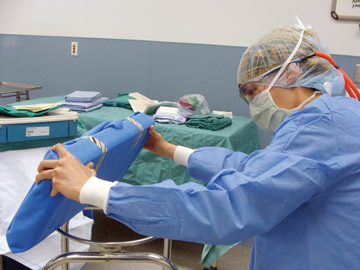Communication Is Key for All Situations
As the leader, you may need to communicate bad news to your team as changes or situations occur....
This website uses cookies. to enhance your browsing experience, serve personalized ads or content, and analyze our traffic. By clicking “Accept & Close”, you consent to our use of cookies. Read our Privacy Policy to learn more.
By: Lucas Higman
Published: 9/11/2019
What's the best way to keep your sterilized instruments free of contaminants and protect them from damage during storage and transport? Most of our clients use some combination of disposable blue wrap and reusable sealed containers. Containers cost more, but they feature rigid bottoms that cannot be penetrated, punctured or torn. Here's how to decide if containers make sense for your facility.
1 Is wrap giving you headaches? The impetus for most facilities to buy containers is when tears and holes in wrap are causing them problems. Let your experience be your guide. A surgical set is unsterile if it was reprocessed in a wrap that was punctured. If you're constantly having problems with wraps, containers might be right for you. The cost of containers is one thing, but the impact of having to cancel cases is another, far more important issue to consider. If you're setting up for a case and you don't have the instrument availability you need, especially if it's a unique procedure that requires a one-of-a-kind surgical set, that often leads to costly delays or case postponements.
2 When will you break even? Initial investment in surgical wrap can be cost effective. How do you figure out when you'll start to save money? Start with your annual cost of buying wrap. If it's $20,000, then call the container manufacturers. They'll give you a quote, and you'll have a simple break-even point. You'll save money in the long run, but you'll need to weigh the savings against the short-term investment.
Thankfully, replacement costs aren't part of your equation. I've seen containers at facilities that are 10 to 15 years old and, as long as they're inspected and maintained, there's no reason why they can't continue to be used to keep instruments sterile for years to come. There are, however, maintenance and parts expenses involved and your cost analysis will go awry if you don't consider them. The gasket under the lid of many containers that creates a seal between the lid and container needs to be in good working order. The locking mechanisms need to be tightened or replaced, but not until many years after you purchase the container. If the container has a filter, make sure it doesn't have any holes in it and that the locks that hold it in place are checked. And, of course, there is a cost for the filters themselves, which are replaced after each use. You can get a maintenance plan from the manufacturer or a third party to address these concerns.
3 Space considerations. Containers take up significantly more space than wrapped surgical trays, so a switch would require considering your facility's layout and workflows. Unless you have an extra set of containers, they'll always be in use. The only thing to keep in mind is that you'll need a staging area for the containers as the surgical sets they transport for decontamination, assembly and inspection are being sterilized. Even though it takes less space to store wrap, some facilities may not consistently adhere to the Association for the Advancement of Medical Instrumentation (AAMI) guidelines. Wrap is often stacked, which leads to creases and punctures that set the unsterilized process into motion.

4 Don't forget about the oddball sets. When you call the manufacturer, be ready to give them a precise inventory of your surgical sets. The size of your sets will determine the size of the containers you'll need and ultimately your cost. When preparing this information, remember to consider loaner sets and sets you have in the facility on consignment. I've known a lot of facilities that haven't taken those specialized orthopedic or surgical sets into consideration. The loaners tend to be odd shapes, which vary from manufacturer to manufacturer. They'll need a special container, or you'll need to have wrap on hand for those sets. Neglecting to take the sets that are not owned by your facility into account could throw off your cost considerations.
5 Consider the weight. Remember the rule of thumb that no surgical set headed for sterilization should weigh more than 25 pounds, including the weight of the container. That's according to the AAMI guidelines and manufacturers' instructions for use (IFU). Not exceeding that weight limit is important for many reasons, from ensuring the sets aren't too tightly packed to reducing the effectiveness of the sterilization process to avoiding injuries from lugging around trays that are too heavy. It's important to abide by these guidelines and IFUs, as this is something surveyors look for during an inspection of your sterile processing department.
You'll have to purchase enough containers to ensure you're in compliance, so that's another consideration in your cost analysis. Wrapped trays weigh less, and some wraps have reinforced corners to prevent rips and tears where they happen most, but the peace of mind that the toughness that a rigid container provides could be worth the extra expense. OSM
As the leader, you may need to communicate bad news to your team as changes or situations occur....
ASC leaders face many challenges in 2025 and increasing revenues will certainly be one of them....
In a modern workplace where change often comes quickly and relentlessly, a leader should embody the concept of learning to embrace an agile mindset....